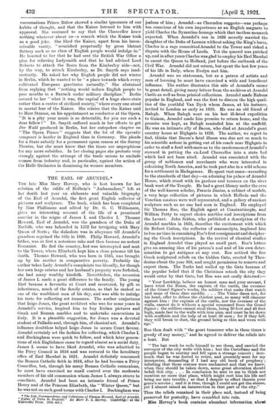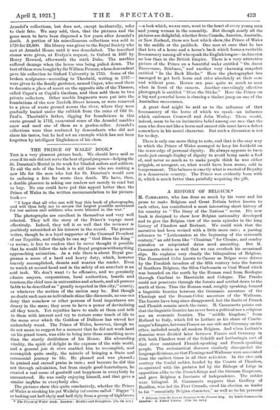THE EARL OF ARUNDEL.* Trrs late Miss Mary Hervey, who
is best known for her solution of the riddle of Holbein's "Ambassadors," left at her death last year an elaborate and valuable biography of the Earl of Arundel, the first great English collector of pictures and sculpture. The book, which has been completed by Miss Phillimore and edited by Dr. G. C. Williamson, gives an interesting account of the life of a prominent courtier in the reigns of James L and Charles I. Thomas Howard, Earl of Arundel, was the grandson of the Duke of Norfolk, who was beheaded in 1572 for intriguing with Mary Queen of Scots ; the dukedom was in abeyance till Arundel's grandson regained the title in 1660. Philip Howard, Arundel's father, was at first a notorious rake and then became an ardent Romanist. He fled the country, but was intercepted and sent to the Tower, where Elizabeth kept him a close prisoner till his death. Thomas Howard, who was born in 1585, was brought up by his mother in comparative poverty. Probably the author takes Lady Arundel's complaints too literally, for though her own large estates and her husband's property were forfeited, she had many wealthy kinsfolk. Nevertheless, the accession of James I. made a great difference to the family. The young Earl became a favourite at Court and recovered, by gift or inheritance, much of the family estates, so that he ranked as one of the wealthiest men of his day, and was able to indulge his taste for collecting art treasures. The author conjectures that Inigo Jones, the great architect who was for some years in Arundel's service, inspired him to buy Italian pictures and Greek and Roman marbles and to undertake excavations in Italy. It is a plausible suggestion, for Jones was a devoted student of Palladio and, through him, of classical art. Arundel's influence doubtless helped Inigo Jones to secure Court favour. Arundel certainly set the fashion for collecting, which Charles I. and Buckingham were quick to follow, and which later genera- tions of rich Englishmen came to regard almost as a social duty, James I. seems to have liked Arundel, who was admitted to the Privy Council in 1616 and was restored to the hereditary office of Earl Marshal in 1621. Arundel definitely renounced the Roman Catholic faith in 1616, after he had become a Privy Councillor, but, through his many Roman Catholic connexions, he must have exercised no small control over the moderate members of his old communion whom James I. always strove to conciliate. Arundel had been an intimate friend of Prince Henry and of the Princess Elizabeth, the " Winter Queen," but he was not on such good terms with Charles L Buckingham was
• The Life. Corr e, and Collections of Thomas Howard. Earl of Arundel, "Father of Vertu in England." Bg Mary F. D. Hervey. Cambridge: at the Univemity Press. [S x. net.)
jealous of him ; Arundel—as Clarendon suggests—was perhaps too conscious of his own importance as an English magnate to yield Charles the Byzantine homage which that tactless monarch expected. When Arundel's son in 1626 secretly married the daughter of the Duke of Lennox without asking the King's leave, Charles in a rage committedArundel to the Tower and risked a dispute with the House of Lords. Yet the quarrel was patched up, and in after years Charles was glad to employ his Earl Marshal to escort the Queen to Holland, just before the outbreak of the Civil War. Arundel did not return, but spent the last few years of his life in Italy, where Evelyn met him.
Arundel was no statesman, but as a patron of artists and men of learning he must have exercised a wide and beneficent influence. The author illustrates this side of Arundel's career in great detail, giving many letters from the archives at Arundel Castle as well as from printed collections. Arundel made Rubens popular in England, and was the first to discern the high quali- ties of the youthful Van Dyck whom James, at his instance, invited to London as early as 1620. He was an old friend of Ralegh. When Ralegh went on his last ill-fated expedition to Guiana, Arundel made him promise to return home, and the promise was kept, as Ralegh reminded him at the scaffold. He was an intimate ally of Bacon, who died at Arundel's great country house at Highgate in 1626. The author, we regret to find, thinks that Bacon's fatal illness was due not so much to his scientific ardour in getting out of his coach near Highgate in order to stuff a fowl with snow as to the carelessness of Arundel's steward in putting the ex-Lord Chancellor into a state bed which had not been aired. Arundel was associated with the group of noblemen and merchants who were interested in colonizing North America, and he took part also in a wild scheme for a settlement in Madagascar. He spent vast sums—according to the standards of that day—on adorning his palace of Arundel House, which stood with its gardens and terraces cn the river bank west of the Temple. He had a great library under the care of the well-known scholar, Francis Junius, a cabinet of medals, a very large collection of pictures in which Holbein and the Venetian masters were well represented, and a gallery of ancient sculpture such as no one had seen in England. He employed Sir Thomas Roe, the English agent at Constantinople, and William Petty to export choice marbles and inscriptions from the Levant. John Belden, who published a description of the Arundel marbles in 1628, describes the excitement with which Sir Robert Cotton, the collector of manuscripts, implored him to lose no time in examining Roe's first consignment and decipher- ing the Greek inscriptions. In the revival of classical studies in England Arundel thus played no small part. Roe's letters give an amusing idea of his patron's zeal and of his own deter- mination to get antiques at any cost. Roe noticed the fine Greek sculptured reliefs on the Golden Gate, erected by Theo- dosius about the year 388, and sought permission to remove and export them. The Turks had walled up the Gate because of the popular belief that if the Christians retook the city they would enter by that Gate, but Roe was not easily deterred :-
" Your Lordship, believe an honest man and your servant, I have tried the Besse, the captain of the castle, the overseer of tho Grand Signor's works, the soldiers that make that watch and none of them dare meddle. . . . The Vizier dares not, for his head, offer to deface the chiefest post, so many will clamour against him : the captain of the castle, nor the overseer of the walls, cannot do it without a special command from the Grand Signor ; the soldiers cannot steal them, being 30 foot and 40 foot high, made fast to the walls with iron pins, and must be let down with scaffolds and the help of at least 50 men ; for if they fall, they will break to dust, the ground being so thin and worn with age."
Roe then dealt with " the great treasurer who in these times is greedy of any money," and he agreed to deliver the reliefs into a boat. But
" The last week he rode himself to see them, and carried the surveyor of the city walls with him ; but the Castellano and the people began to mutiny and fell upon a strange conceit ; inso- much that he was forced to retire, and presently 'sent for my interpreter, demanding if I had any old book of prophecy ; inferring that those statues were enchanted and that we knew, when they should be taken down, some great alteration should befall this city. . . . In conclusion he sent to me to think nor mention no more that place, which might cost him his life and bring me into trouble ; so that I despair to effect therein your grace's service • and it is true, though I could not get the stones, yet I almost raised an insurrection in that part of the city."
Thus the reliefs remained in their place and, instead of being preserved for posterity, have crumbled into ruin.
Miss Hervey's book contains abundant information about
Arundel's collections, but does not, except incidentally, refer to their fate. We may add, then, that the pictures and the gems seem to have been dispersed a few years after Arundel's death. A portion of his miscellaneous collections was sold in 1720 for £8,800. His library was given to the Royal Society who met at Arundel House until it was demolished. The inscribed stones were given, at Evelyn's request, to Oxford in 1667 by Henry. Howard, afterwards the sixth Duke. The marbles suffered damage when the house was being pulled down. The best of them were boughtisy Sir William Fermor, whose descendant gave his collection to Oxford University in 1755. Some of the broken sculptures—according to Theobald, writing in 1757— were given to the family gardener, named Cuper, who used them to decorate a place of resort on the opposite side of the Thames, called Cuper's or Cupid's Gardens, and then sold them to two private collectors. Other marble fragments were put into the foundations of the new Norfolk Street houses, or were removed to a piece of waste ground across the river, where they were gradually buried under the rubbish from the ruins of Old St. Paul's. Theobald's father, digging for foundations in this waste ground in 1712, excavated some of the Arundel marbles anew and used one of them as a garden-roller. Arundel's collections were thus scattered by descendants who did not share his tastes, but he had set an example which has not been forgotten by intelligent Englishmen of his class.



































 Previous page
Previous page